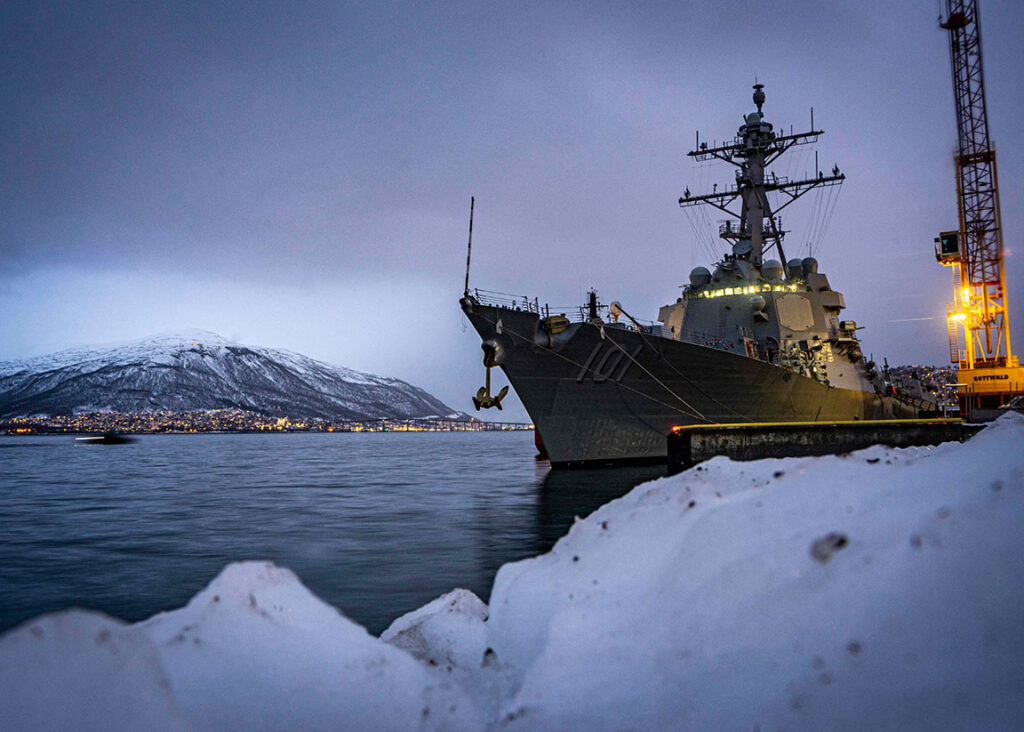The guided-missile destroyer USS Gridley stops for fuel in Tromso, Norway, in 2019. The Department of Defense issued a new Arctic strategy in July 2024 outlining a strategy built on engagement and collaboration with U.S. Arctic allies such as Norway. U.S. NAVY
TROY J. BOUFFARD, PH.D/UNIVERSITY OF ALASKA FAIRBANKS
The 2024 Department of Defense Arctic Strategy adeptly reflects the region’s geopolitical landscape since February 2022. Notably, its end state — to preserve the Arctic as a stable region where U.S. homeland security and vital national interests are safeguarded — presents a more assertive objective than its 2019 predecessor. This shift is both necessary and timely. The strategy explicitly references U.S. allies and partners in its efforts and scope of cooperation, while the emphasis on “preserving” suggests a more defensive posture aimed at maintaining the current order.
Furthermore, the strategy articulates a clear intent to “strengthen the ability of the United States to build integrated deterrence and effectively manage risk to U.S. interests” through three primary themes:
- Enhance domain awareness and Arctic capabilities.
- Engage with allies, partners and key stakeholders.
- Exercise tailored presence.
Enhance
Domain awareness remains a paramount challenge for operational authorities throughout the Arctic, spanning both physical and non-physical domains. U.S. Northern Command, serving as the lead Arctic advocate for the Department of Defense, has long prioritized this critical aspect. The strategy provides guidance on technological improvements designed to bolster the Joint Force’s ability to “monitor and respond” to Arctic threats, as well as enhance capabilities across multiple domains. It emphasizes leveraging partnerships with allies, other government agencies and commercial entities in key technological areas, with a particular focus on space-based systems.
Moreover, the enhancement of awareness and capabilities offers promising avenues for the United States and its allies to pool resources for research and development, facilitate realistic training opportunities, improve situational awareness, share intelligence, test emerging technologies and harness collective Arctic expertise.
Engage
In recent years, engagement with U.S. allies and partners has taken on renewed significance. It is imperative to consistently underscore that the United States Department of Defense can count on seven national allies in the Arctic, numerous public and private sector partners, and leadership roles in key alliances. This stands in stark contrast to Russia’s relative isolation in the region. Engagement manifests not merely through rhetoric but also through concrete actions and operational conduct, demonstrating the seriousness of allied commitments. This dynamic likely serves as a source of frustration for adversaries, particularly Russia, whose military advancements in the Arctic face considerable challenges.
Engagement will also facilitate improvements in operational capabilities, including total force interoperability, NATO warfighting skills, special operations cooperation, advanced experimentation, federal interagency coordination, research collaboration and the integration of Indigenous knowledge.
Exercise
As security-related concerns grow in tandem with increased access and activities throughout the Arctic, the importance of presence continues to expand. While the United States and its allies maintain decisive superiority in aerospace and maritime subsurface capabilities, these strategic assets are reserved for the most extreme circumstances. Below the threshold of conflict and short of crises, it is crucial to develop and conduct presence-related capabilities to manage a more likely array of potential issues.
Presence — whether persistent or intermittent — remains critical in facilitating awareness and managing security issues. Presence serves as a fundamental operational requirement to prevent incidents from escalating and to preclude adversaries from exploiting any perceived lack of U.S. operational capabilities. Military exercises represent the best method to demonstrate presence capabilities, with deliberate design, execution and assessment based primarily on defense strategy guidance.
Conclusion
The 2024 DOD Arctic Strategy effectively employs an “ends, ways and means” structure to align strategic requirements with pathways to success. The strategy clearly delineates ends with ways formed through the themes discussed above, providing an excellent categorical structure to guide Arctic priorities as items in combatant command lines of operations and lines of effort. Many activities, particularly exercises, already provide effective means, and the new strategy ensures the ability to oversee current domestic and global dynamics while maintaining adaptability to plausible future scenarios.
Developing operational skills and competence in the Arctic’s extreme environment will require time and effort, as the region often presents operational complexities yet to be fully identified and defined. Whether at the scale of expeditionary or large-scale combat operations, the strategy must inform and guide the development of proficiency in precision-enabled, all-domain, combined arms warfare. Success will hinge on the strategy’s ability to guide the advancement of capabilities at joint, service-component, interagency and combined (multinational) levels.
While resourcing and implementation may present challenges in operationalizing this strategy, particularly given the diverse array of actors with DOD-associated responsibilities and equities in the Arctic, the comprehensive and forward-looking nature of the 2024 DOD Arctic Strategy positions the United States and its allies to effectively navigate the complex security landscape of this critical region for years to come.
Dr. Troy Bouffard is the director of the Center for Arctic Security and Resilience at the University of Alaska Fairbanks. His experience and expertise include Arctic defense and security issues with the DOD and NATO as well as geopolitical and diplomatic Arctic affairs to include the Arctic Council, and continuing research in the social and natural sciences of the Arctic. The opinions expressed do not necessarily represent the policies or points of view of USNORTHCOM or the United States government.

